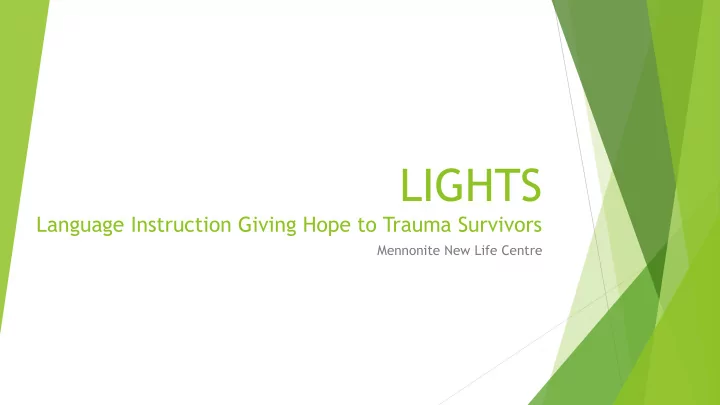

LIGHTS Language Instruction Giving Hope to Trauma Survivors Mennonite New Life Centre
LIGHTS Summary We are delighted to introduce you to LIGHTS (Language Instruction Giving Hope to Trauma Survivors) which is an alternative language training program for vulnerable learners who need extra support. The focus of the LIGHTS Program is to provide functional second language instruction to newcomers who experience emotional, cognitive or academic barriers to learn English in a traditional ESL or LINC class. Often these barriers prevent newcomers from functioning at the same level as the average learners. We help our learners to become integrated and productive . We also facilitate their insertion into ESL or LINC programs in the future.
Who can apply? Immigrants who are refugee claimants, convention refugees, permanent residents and citizens who experience barriers such as: Difficulty succeeding in traditional English classes Limited knowledge of English (CLBs 0-3) Emotional and/or mental health issues that prevent them from learning Inability to access mental health support due to insufficient language level Physical disabilities or medical conditions Candidates are invited to an intake interview in order to make sure they qualify
LIGHTS Classes Stress-free, safe, welcoming, flexible and supportive learning environment Integrate educational needs with the learners’ physical and psychological needs. Individual and group coaching from professionals in areas such as mindfulness, wellness, meditation, relaxation, art, and drama Small groups of up to 10 learners, richer learner-instructor interactions 3 hours per week for 12 weeks Empower students to continue learning language and navigating social opportunities Specialized curriculum delivered by two instructors from different fields at the same time Use of students’ mother tongue for clarification Mind maps, flash cards, role-playing, growth mindset activities, oral assessment and observation.
For interested organizations: We offer the delivery of the program at your site for learners’ convenience and we also offer training for your instructors. If you are interested in hosting a cohort of LIGHTS for the following intake, or to refer clients , please contact the program manager: Leticia Esquivel (lesquivel@mnlct.org) Next session starts on Jan 7, 2019
Dealing with a person with limited English abilities might be a frustrating experience for both of you. Here are some tips to make the best of your meeting: Be human , respectful , sensitive , empathetic , and patient Put yourself in their shoes and take actions to accommodate their needs Give enough time : allow the client time to listen, think and respond, both to questions and to statements, don't rush, or put pressure Smile , don't show frustration or impatience Inform the client that they can ask you to clarify information and provide further explanations Do not judge or stereotype Remember that they do not understand Canadian social norms, such as eye contact and personal space, so don't feel offended! Be aware of cultural preferences and differences Expect concentration to decrease during your interview. Start with the most important points Don't depend on their computer skills or ask them to refer to the website Consider that some might not even know how to write or read in their native language Always provide a written copy of whatever is required; document, action, information, etc It is always a good idea to have important documents or instructions translated into different languages Many have hearing or vision impairment , don't whisper and don't print using a tiny font Maintain your sense of humor!
Language: Communicate one idea per sentence Shorten and simplify your sentences and highlight content words Pronounce your words fully and remember to pause when needed, use intonation to clarify meaning Consider the fact that your dialect may not be what the other person has learned in school Do not cover or hide your mouth because listeners will want to watch you as you pronounce your words Remember that English is very confusing for them. Eg. Through, throw, thorough Slow down your speech. However, be careful not to speak to someone like they’re dumb Do not depend on repetition and slower paced sentences, instead Use synonyms (more general or more specific), examples , pictures , body language , show them the word, use a dictionary , seek interpretation through a coworker (if possible), use Google translate Avoid : slang, jargon, idioms, acronyms, short forms, phrasal verbs, complex words (except with speakers of languages that are rooted in Latin), closed questions (questions that require only a ‘yes’ or a ‘no’ answer), and running words into each other. Offer a pen and a paper , they might be able to write the word or draw a picture to help you understand, or ask them to show you a picture.
Understanding: Check understanding regularly and at the end Keep in mind that “ no questions ” sometimes mean “ no understanding ”, and a nod does not mean they understand Paraphrase and summarize their respond; repeat in your own words what you think the person is saying Ask the client to repeat important points Take responsibility for being clear. Say, “I’m not sure I explained this very well. Tell me in your own words what you understand about ………” Find out whether the client has understood you by being alert for signals that indicate that the person does not understand. Examples include a blank look, frowns, fidgeting or an effort to change the subject . Be mindful, however, that body language can vary between cultures. Finally, learn a few polite expressions in different languages A simple ‘good morning’ or ‘thank you’ in the client’s native language will go a long way toward improving your relationship and building trust.
Thank you for listening LIGHTS team Mennonite New Life Centre
References https://mnlct.org/lights/ https://www.business2community.com/strategy/5-tips-when-interacting-with- people-who-speak-english-as-a-2nd-language-esl-0197279 https://bizfluent.com/how-5907060-communicate-people-speak-limited- english.html https://www.dummies.com/business/customers/how-to-deal-with-a-customers- language-barrier/ https://www.ceh.org.au/speaking-clients-low-english-proficiency/ https://www.wikihow.com/Communicate-with-a-Non-Native-English-Speaker
Recommend
More recommend